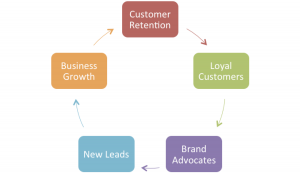In the age of cut-throat competition, Business organizations are spending whopping dollars to influence new customers, retain old customers and increase the customer lifetime value (CLV). While uniqueness of business strategies and innovative marketing are the two decisive factors typically driving the Customer Retention and Customer Lifetime Value (CLV), the importance of Customer engagement and personalized bonding cannot be ignored.
So why are Customer Retention and Lifetime Customer Value the new buzz words?
Staying ahead in the copy-cat competition
Products and services offered by a certain business organization are easy for rival companies to copy. They could probably offer the same service at a discounted price but at a compromised quality. In majority of cases a new customer would be driven by the immediate benefits of a discounted price rather than judging the long-term quality loopholes. As a result, the existence of your product or service could be threatened.
A solid customer retention strategy is important to shield your business against such vulnerabilities. For example, at a Student learning could implement customer engagement & retention programs such as Customer feedbacks, testimonials, surveys, automated email notifications, student award programs and daily home assignments. The idea is to involve parents in the education process.
Evaluate Policy & campaign Effectiveness
Customer retention percentage and lifetime customer value could be two important parameters to measure the effectiveness of marketing policies and various campaigns. The personalized offers, strategic discounts, customer engagement programs play a decisive role while motivating existing customers to continue their relation with a brand. Customer Retention percentages are a definitive parameter that could measure the success of such marketing initiatives.
For example, measuring the Customer Lifetime Value for a subscription based business such as Student learning Center, could be the number of leads and conversions that a particular loyal customer has triggered through his/her recommendations and feedbacks.
Tailor Made Strategies for Customer Segments
“One Plan Fits All” is a concept that has gradually taken a back seat, owing to the increase in competition and consumer awareness. It is therefore imperative that Business organizations devise marketing strategies based on customer segments and demographics. And customer retention majorly drives the decisions for segment based marketing. Customer retention numbers help marketers in chalking out innovative plans targeted towards engaging customers from various age groups, financial backgrounds, and geographic preferences. Customer Lifetime Value on the other hand defines the “long-term” strategies to keep the consumer engaged.

Customer Acquisition is expensive
Customer engagement programs are extremely effective when it comes to gathering new leads and improving Sales funnel.
A loyal customer is 67% more likely to recommend your products or services to his/her peer groups. With friends, office colleagues, family, relatives, social media circuits and other social groups, the exposure your business gets through sheer recommendation is astronomical.
Increasing Customer Lifetime Value therefore serves as an indirect means to capture more and more customers, without any substantial marketing investment whatsoever.
Conclusion
Customer retention and engagement programs are pivotal for the success and growth of every business process, including most subscription based earning programs. Parents are very cautious when it comes to selecting a quality education program of their children. Continuous communication, updates and notification sent out to parents, convince them of how responsible and concerned the Learning center is. With an increased Customer Lifetime Value, there’s a strong possibility of increased enrollments and potential new leads.


Recent Comments